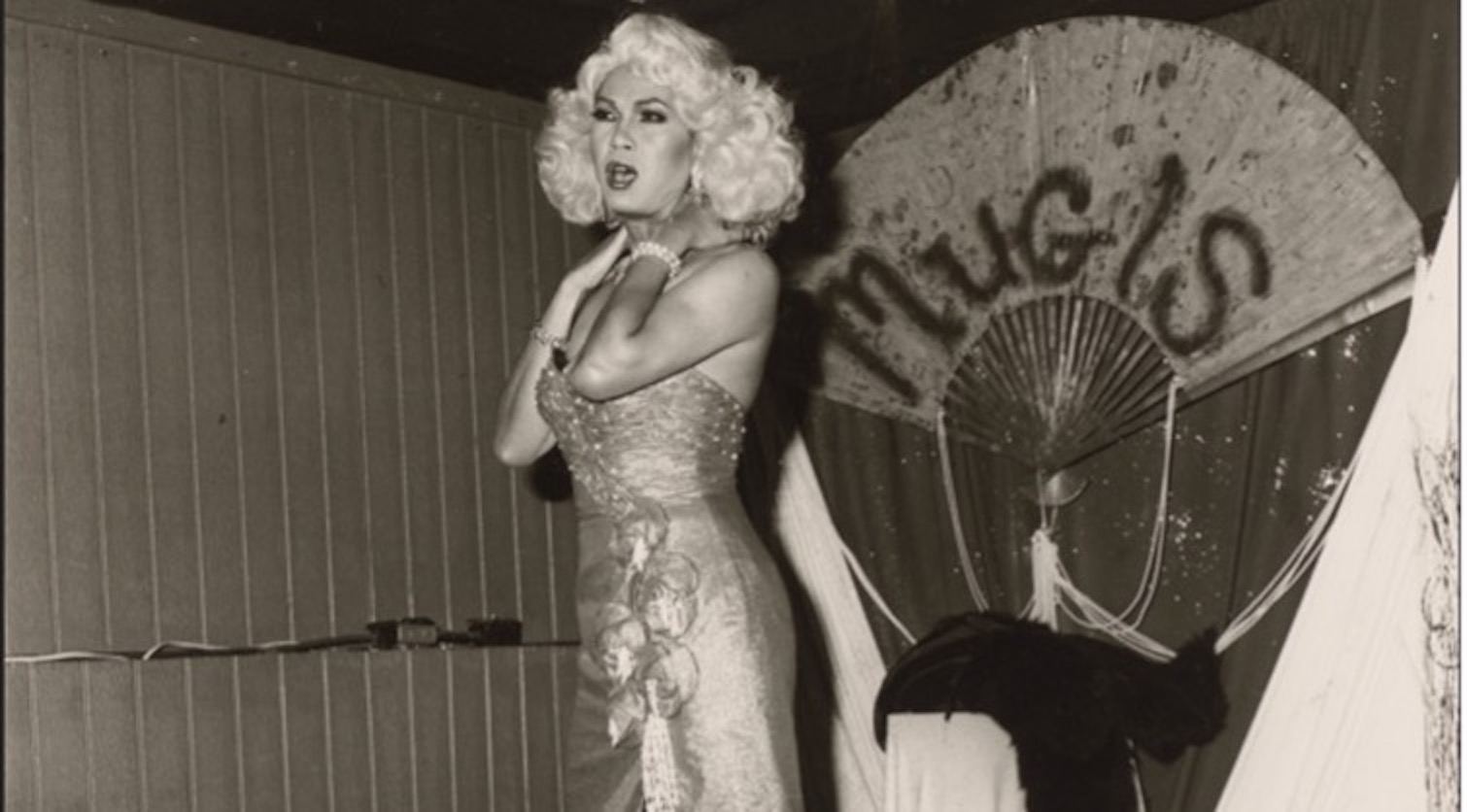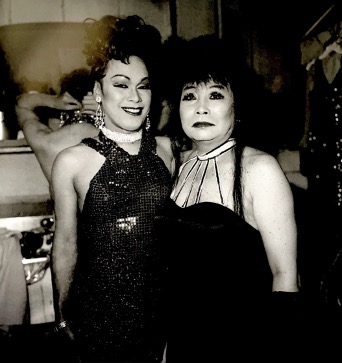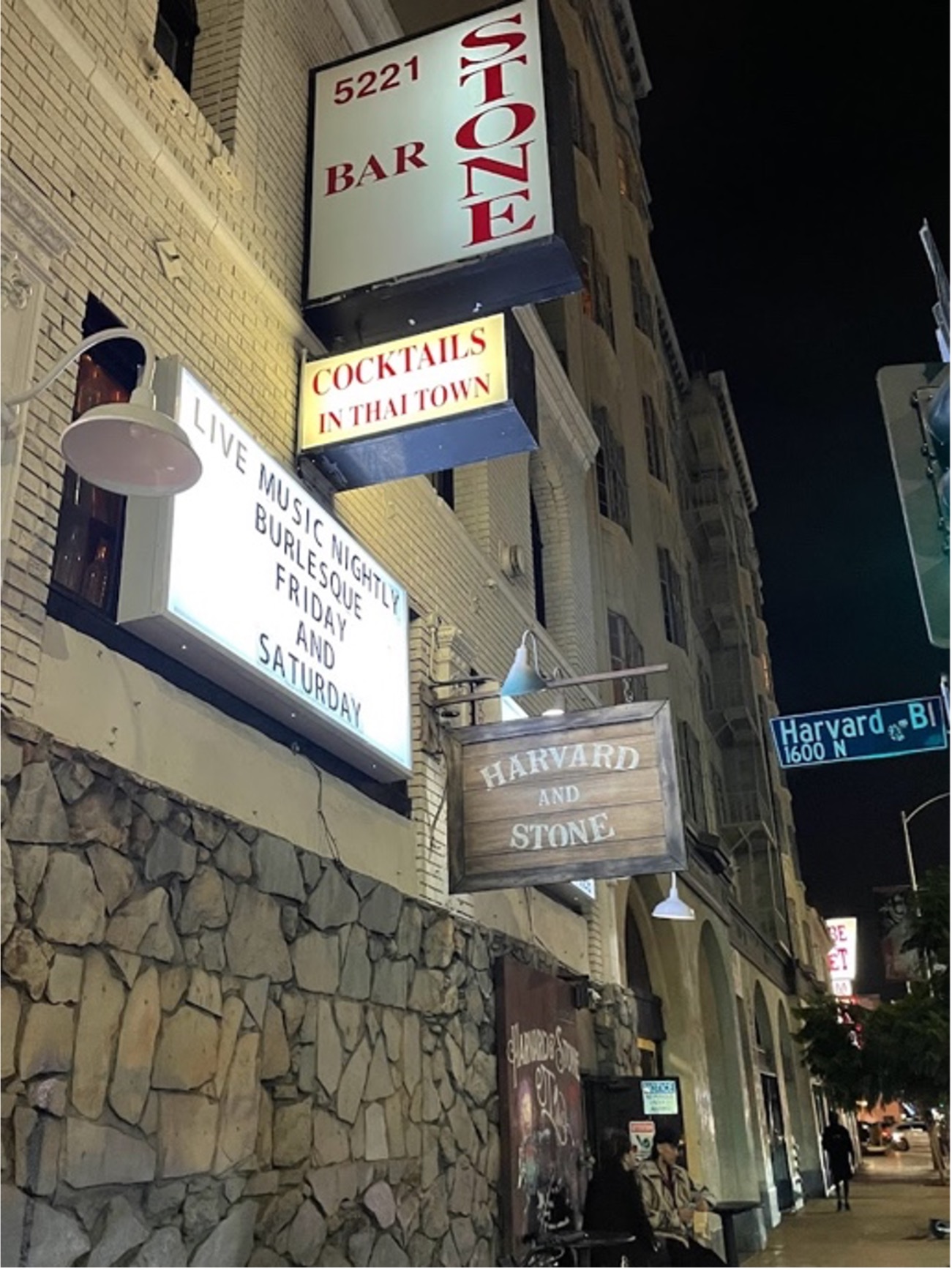Beyond the “Rice Bar:” A History of Mugi’s

Figure 1. Performer at Mugi's in 1990. Photo by Reynaldo Rivera.
Despite The Advocate’s claim of Hollywood being an “Ellis Island’ for gay men, this proved not to be the case for gay Asian men.1 Across the intersections of race, nationality, class, and sexuality gay Asian men lacked a “safe space” within Los Angeles. Within his interviews of gay Asian men, Eric C. Wat found a recurring pattern that gay Asians in the 70s and 80s were “spread out” within Los Angeles, often patronizing “white bars” where they faced racism and fetishization.2 However, a unique listing in the Bob Damron guides reveals a location dedicated to gay Asian men, Mugi’s.
Mugi’s first appeared within the Bob Damron guides in 1980. While Mugi’s is noted as a Japanese restaurant within the description, the amenity feature for Asian spaces, “(MRC-A),” does not appear in the Bob Damron guides until 1994. In fact, Mugi’s is one of only three locations in the 1994 guides with this amenity feature. However, a deeper look into Mugi’s history reveals that, despite the lack of ‘(MRC-A)’ spaces listed in the guides, it served as a gathering place for the gay Asian community in Los Angeles.
Although Mugi’s appears in the guides in 1980, Mugi’s celebrated its grand-opening on December 16, 1978, in East Hollywood at 5221 Hollywood Blvd.3 Opened by Yoshi Sasaki, Mugi’s originally opened as a restaurant that sold Japanese food with an accompanied counter bar. Promising to be a location, “where the Orient mingles with modern America,” Mugi’s interior included rice paper lanterns, tatami flooring, and shoji screens.4 However, the popularity of the bar among gay Asian men encouraged Yoshi to transform Mugi’s solely into a gay bar in 1981. As a result, a diverse community of gay Asian men including Japanese, Filipinos, Chinese and Thai men gathered at Mugi’s, creating a space for gay Asian men.
Mugi’s proved to be more than a social bar due to its participation in supporting social organizations and fundraising events. As Mugi’s attracted many gay Asian men, the Asian/Pacific Lesbians and Gays (A/PLG) organization utilized its space to recruit members. Within A/PLG newsletters, Yoshi (the owner) is thanked repeatedly for providing space and support for the organization and is even referred to as “Mama-Yoshi.”5 Additionally, within the 90s it is documented that Mugi’s held drag shows and donated funds to the HIV/AIDS relief.6 Photographs of drag performers, including Yoshi at Mugi’s can be viewed in Reynaldo Rivera’s Reynaldo Rivera: Provisional Notes for a Disappeared City (2020). The photographs capture the extravagance of Mugi’s and the diversity of its patrons.

Figure 2. Tina and Yoshi, Mugy's (1995). Photo by Reynaldo Rivera.
As word spread of Mugi’s Asian population, non-Asian patrons intrigued by the crowd began to visit. Although word-of-mouth may have been a factor in attracting non-Asian gay men, Mugi’s early advertisements also played a role.. Earlier descriptions of Mugi’s as a location with “international flavor” and even Mugi’s own promise of providing a place where “the Orient meets modern America” opens an invitation to non-Asian patrons.7 This advertisement of Mugi’s proved to be effective as by 1982, the Update: Southern California’s Gay NEWSpaper reports that Mugi’s is “packed” with a crowd of 50/50 Caucasians and Asians.8 However, the words “mingle” and “flavor” have sexual undertones, hinting at the fetishization of Asian men. It is this language and publicity that transformed Mugi’s into a “rice bar.”
Rice bars are defined as places that are predominantly populated by gay White and Asian men that often functioned as “sites of ethnic tourism for “rice queens,” or white gay men,” who had a sexual preference in Asian men.9 While the acquaintance of White men may have introduced Asian men to spaces within the Los Angeles gay world, or in some cases the American world in general, their presence led to underlying racial tensions within Mugi’s. For example, uncomfortable with Yoshi’s camaraderie with Japanese patrons, Reggie Bogan, a self-identified “rice-queen” and bartender of Mugi’s revealed in an interview that he told Yoshi, “You ought to speak English more.”10 Asian patrons also faced discomfort among the presence of “rice queens.” Founding board members of A/PLG, Tak Yamamoto, Andy Cheah, Doug Chin, and Roy Kawasaki revealed that in Mugi’s most of the non-Asians “tended to be a lot older, at least in their thirties and forties,” while they were in their twenties.11 Understanding this discomfort of the patrons, Yoshi attempted to address it by hiring only gay Asian men. However, by the 90s, Mugi’s status as a “rice bar” and the negligence of reported robberies at the bar may have led to the decline of Mugi’s.
While Mugi’s closing date is unclear, the location’s last appearance in the Bob Damron guides is in 1997. After this year, the bar goes under multiple owners and consequently many names. In 1998, the location is renamed Ming’s Dynasty and still has the “(MRC-A)” amenity feature. However, in 2002, the bar is renamed the Stone Bar. While the bar is still listed as an “Asian gay bar,” the bar limits the patronage of gay men to particular days, in this case Sunday and Thursday. By 2004, these days would be limited to Fridays.

Figure 3. Harvard & Stone Bar in 2022. Photo by Piranyan Hovik via Google Reviews.
Between 2006 and 2009, there are no listings of the 5221 Hollywood Blvd. location in the Bob Damron guides. The Stone Bar briefly returned between 2010 and 2011 but the amenity feature of “(MRC-A)” has vanished. In 2011, the location received new owners and a new name, the Harvard & Stone Bar, which is currently open as of 2023. Seemingly aware of the location’s gay history, Harvard & Stone attempts to dissociate from it and even regulates their dress code which “highly” discourages “loud colors.”12 However, the history of Mugi’s lingers, symbolized by a sign with gay argot that hovers above Harvard & Stone, promising cocktails in Thai Town. In the ever-changing landscape of Los Angeles, the legacy of Mugi’s serves as a poignant reminder of the city’s diverse and complex LGBTQ+ history, and the enduring quest for safe spaces within the community.
-
John Calendo,“Boys Just Want to Have Fun,” The Advocate, July 24, 1984, pp. 16-19, 16. ↩︎
-
Eric C Wat, “Gay Asian Men in Los Angeles Before the 1980s,” in Contemporary Asian American Communities Intersections and Divergences, ed. Linda Trinh Vo and Rick Bonus (Philadelphia, PA: Temple University Press, 2002), pp. 75-88, 76. ↩︎
-
“Advertisement: MUGI.” 1978. The Advocate, Dec 27, 44. https://www.proquest.com/magazines/advertisement-mugi/docview/2371038785/se-2. ↩︎
-
“Advertisement: Mugi.“1979. The Advocate, Jun 14, 14. https://www.proquest.com/magazines/advertisement-mugi/docview/2371039972/se-2. ↩︎
-
Newsletters of A/PLG 1981-1986. 1981-1986. MS Box 1, Folder 9, Asian Pacific Lesbians and Gays (A/PLG) Records. ONE National Gay & Lesbian Archives. Archives of Sexuality and Gender (accessed April 25, 2023). https://link-gale-com.lib-proxy.fullerton.edu/apps/doc/AXJRDO973915298/AHSI?u=csuf_main&sid=bookmark-AHSI&xid=75691f30&pg=130. ↩︎
-
Bill Weaver. Annual Fundraising Report for Aid to AIDS, July 1983-July 1984. https://search.alexanderstreet.com/view/work/bibliographic_entity%7Cbibliographic_details%7C3221418. ↩︎
-
Calendo, 18. ↩︎
-
Lair Davis, “Out & about Los Angeles.” Update, April 9, 1982, 9. Archives of Sexuality and Gender (accessed April 25, 2023). https://link-gale-com.lib-proxy.fullerton.edu/apps/doc/DFCDRR792393827/AHSI?u=csuf_main&sid=bookmark-AHSI&xid=1ffe8b5b. ↩︎
-
Wat, 76. ↩︎
-
Eric C. Wat, The Making of a Gay Asian Community: An Oral History of Pre-AIDS Los Angeles (Lanham, MD: Rowman & Littlefield; Littlefield Publishers, Inc, 2002), 78. ↩︎
-
Oral History courtesy of The Lawrence de Graaf Center for Oral and Public History. ↩︎
-
Harvard & Stone, accessed April 25, 2023, http://harvardandstone.com/. ↩︎